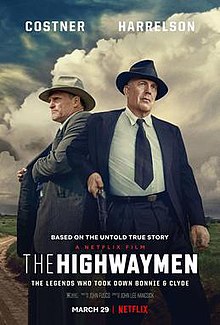Costner and Harrelson take us on a new road in ‘The Highwaymen’
Directed by: John Lee Hancock
Written by: John Fusco
Starring: Kevin Costner and Woody Harrelson
“The Highwaymen” – Hollywood superstars Faye Dunaway and Warren Beatty famously portrayed the infamous outlaws Bonnie and Clyde in the 1967 movie of the same name. Fifty-two years later, two other film icons star in a very different Bonnie and Clyde picture. John Lee Hancock’s “The Highwaymen” centers around Texas Rangers Frank Hamer and Maney Gault - played by Kevin Costner and Woody Harrelson, respectively - who chase down Bonnie and Clyde.
It’s 1934, and Bonnie (Emily Brobst) and Clyde (Edward Bossert) have left a soiled trail of robberies and murders in their wake. Law enforcement is chasing ghosts, because the 20-something gangsters orchestrate numerous disappearing acts in plain sight. After they engineer a prison break at the Eastham Prison Farm in Houston County, Texas, governor Ma Ferguson (Kathy Bates) becomes absolutely desperate for a solution, and prison chief Lee Simmons (John Carroll Lynch) recruits Frank Hamer, a retired Texas Ranger to rein in the maniacal pair.
Hamer is a manhunter with 16 bullets lodged in his body after a couple decades of violent confrontations splattered on his resume, and his old friend and Ranger-partner Maney Gault joins him to help even the odds between law enforcers and law breakers. Ferguson, meanwhile, doubts Simmons’ judgment for “putting cowboys on Bonnie and Clyde”, but these two men also question themselves during their slow-burning pursuit.
Are they too old to track down these kids?
Do they have enough fight left?
While they chase down the aforementioned ghosts, will their past-demons undo their present?
These are legitimate concerns, and Hancock (“The Founder” (2016), “The Blind Side” (2009)) and screenwriter John Fusco (“Young Guns” (1988), “Hidalgo” (2004)) explore Hamer and Gault’s friendship, their wounded souls and varying abilities to manage their pain.
Costner and Harrelson are perfectly cast.
Costner’s Hamer compartmentalizes his past deeds. He lives comfortably with his beautiful wife Gladys (Kim Dickens) in a large country home, but thoughts of past sins invisibly reveal themselves through his quiet demeanor and etched crow’s feet. Still, Hamer proves that pushing forward for a better-tomorrow and sifting through a troubling-yesterday can coexist.
Maney actively joined in the same lead-laden shootouts, but his coping mechanisms carry less resistance. The toil of his former, necessary deeds has left him vulnerable to vices and the misery of inaction. These two wounded lawmen embark on a new, dark journey, but Hancock remarked that they are like “an old married couple”, as evidenced by Frank’s objections to Maney’s singing, drinking and repeated offers to drive.
Costner is so well-versed at playing accessible, “aw, shucks” heroes who cope with the past, and just look to “Tin Cup” (1996), “Open Range” (2003) and “McFarland, USA” (2015) as spot-on examples. In turn, Harrelson can fall into troubled antagonists – like in “The Messenger” (2009), “The Glass Castle” (2017) and “Three Billboards Outside Ebbing, Missouri” (2017) - with the greatest of ease.
With all this space to develop Hamer and Gault’s working relationship along the dusty Texas, Louisiana and Oklahoma highways, the film leaves little time for Bonnie and Clyde, but that’s by design. Hancock and Fusco portray the criminals on-the-run as a mystery, and this decision feels entirely fitting. These stylized, submachine gun-carrying misfits have met their match with a pair of old-fashioned gunslingers from another era. Frank and Maney are in quiet, methodical pursuit, but Bonnie and Clyde just don’t know it. Neither did this critic.
(3/4 stars)
Jeff – a member of the Phoenix Critics Circle – has penned film reviews since 2008 and graduated from ASU’s Walter Cronkite School of Journalism. Follow Jeff and the Phoenix Film Festival on Twitter @MitchFilmCritic and @PhoenixFilmFest, respectively.










